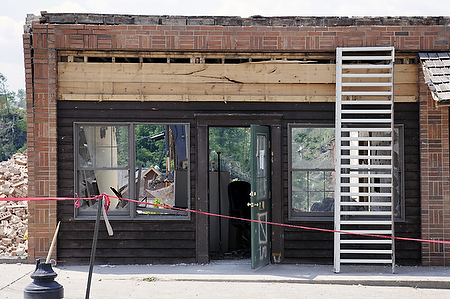Having a Backup of Company Data Does Not Mean You Have a Disaster Recovery Plan Featured
- Written by Top Speed
- Published in Backups
- Read 14292 times
- font size decrease font size increase font size
- Be the first to comment!
You've heard over and over again that you must have a secure backup of your company data, but have you stopped to consider what you'd do in the event of a disaster? How would that data be restored to a fully functioning office environment?
The answer to those questions hinges on two variables - first what was the nature of the disaster? Second what type of backup do you have?
Put in slightly different terms, having a backup of your company's data merely means that you have a copy stored somewhere, it does not mean you have an instantaneous way to restore your company's network back to full functionality. This is not what you want to hear and comes as a shock to many business owners who thought they'd done what they needed to do by having a backup of their data.
The reality is having a backup is only a piece of a business's Disaster Recovery Plan.
What kinds of disasters do business owners need to prepare for?
- Hardware failures - depending on the failure this could mean not being able to access databases, accounting programs, customer records, email, sales programs, design or engineering programs, the list goes on and on. In this scenario you will also likely be waiting on replacement parts to fix the hardware leaving you down for an extended amount of time. But there are still ways to mitigate the length of time you are down.
- Natural Disaster (fire, flood, tornado, earthquake) - depending on the extent of the disaster this could completely destroy your computer hardware and if you're solely relying on a network attached storage device, or tape backups, you need to consider that you really have no backup at all. 44% of businesses who suffer a loss due to a natural disaster Never Recover.
- Theft / intentional destruction of property / human error - In the case of theft of a laptop during a crime of opportunity, or simple human error a simple restoration of the lost files may be all you need; as long as that laptop was included in the backup procedures. However, an orchestrated theft of office equipment, or willful destruction of equipment like the UK case of the employee using chemicals to destroy servers is a different story, where you will again be waiting for replacement parts or equipment to get back up and running.
In the case of human error or only a single system lost (like a laptop), restoring the file or files from backup will get you back on your way. You do have the extra considerations of proprietary company information in the hands of the laptop thief, and that should be considered as you set network security requirements on all devices (business or personal devices that hold company data). This is what most people think of when they think of reasons to have a backup and these are the most frequent reasons companies access their backed up data. But let's move on and consider the more serious cases that involve damaged, destroyed or stolen servers.
 So here's a scenario, there was a fire in your office building, your offices are still there, but due to the sprinkler system everything is soaking wet, from paperwork to your server, it's all a mess. While you run a NAS (network attached storage) you also have an a full online backup so you feel secure that you'll be able to get back up and running. But what now?
So here's a scenario, there was a fire in your office building, your offices are still there, but due to the sprinkler system everything is soaking wet, from paperwork to your server, it's all a mess. While you run a NAS (network attached storage) you also have an a full online backup so you feel secure that you'll be able to get back up and running. But what now?
You have your data, but without an operable server you have not where to put it. Beyond that comes the question of what kind of backup is it? Is it a backup of the data or is it a full Disk Image backup?
What's the difference you ask?
A backup of just your data works when you lose files, but when you lose hardware you also suddenly realize that once you've purchased that new server you have to load the operating system, network settings, software and possibly more back on to it, which is a time consuming process to say the least. And what happens if those software disks and licensing keys are also now also buried in the wet muck? That's where a Disk Image backup comes in to play.
A Disk Image backup is an exact copy (image) of your server. From the operating system, networking settings, programs, and files it's all there. So while you still have to purchase a new server, your company downtime is cut significantly when you can quickly load that Disk Image.
So now we've looked at the types of disasters and backup options your company has, what are the next steps in putting together a real Disaster Recovery Plan?
First consider the how different scenarios could affect your business. Answers will vary depending on your type of business or the specific location - retail vs office vs warehouse vs flex - each has it's own unique issues. More importantly a disaster recovery plan also isn't just for your technology; it's basically your backup plan for running your entire business. You need to keep providing sales & service, paying your vendors and employees, and everything else that goes into your day to day operations.
If you have a retail store, what is your backup plan for accepting payments if the Internet is down and you can't swipe credit cards? If you are a warehousing company and a tornado does major structural damage, how do you move forward? Large companies have usually put a lot of thought into these what ifs, but small to medium size companies don't have that kind of dedicated staff.
Second make a list of everything that is mission critical to your business's daily operations, given the scenarios you've come up with, what is your backup plan to make sure all of this list can still be completed.
Third you should have a specific section for your technology; this is where to include your backup plan, types of backups you have, their locations, how often you backup, the extent and role of employee data stored on personal devices, and how you would get your technology backup and running in the case of a disaster.
If you have any questions about your current backups or would like help with the technology portion of your disaster recovery plan, give us a call and we'll go over what you currently have in place and what your options are.
If you're currently using a backup method like Mozy, Carbonite or Back Blaze you likely will not have a business level back up in place. These three are best suited for a home computer environment and are unlikely be providing you the backup you need. To learn more about business enterprise backup solutions visit our site.

